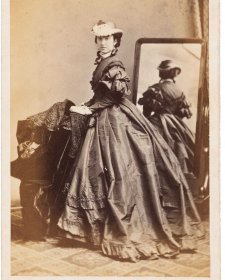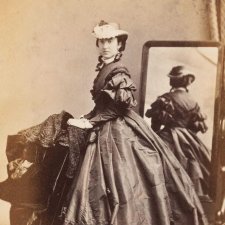Temporary road closures will be in place around the Gallery until 11 March during the Enlighten Festival.
Launceston-born dramatic artist, Hattie Shepparde (1846–1874) played throughout Australia and New Zealand in the years before her untimely death at age twenty-six. Celebrated for ‘her intelligence, her ease, the grace of her manner and her thorough devotion to her art’, Shepparde had begun her career at an early age, appearing for the first time in the burlesque of ‘Atalanta’ at the old Victoria Theatre in Adelaide. In 1851, aged five, she trod the boards at the Princess Theatre in Melbourne, appearing as a young Agnes in David Copperfield. Almost ten years later, she performed on the occasion of opening George Coppin’s Haymarket Theatre on Bourke Street, playing the memorable ‘sick gal’ in the then-notorious comedy American Cousin. Shepparde toured Ballarat, Tasmania and Adelaide before venturing to New Zealand and appearing in ‘all the towns where there was a theatre’ over a five year period. She returned to Sydney in 1870, touring the country districts of New South Wales, performing comediettas and scenes from larger plays in a portable theatre similar to a pitched tent style ‘geggy’. In her final years, she performed with much public favour for audiences in Victoria and in Adelaide, winning praise for her ‘elegant comedy and her angular versatility’. As the ‘most rising of all Melbourne actresses’, Shepparde was held in such high regard for her talent, that she was presented a valuable diamond bracelet by a Committee of ‘influential citizens’ at a reception following her appearance as Esther Eccles in Thomas Roberston’s comedy drama, Caste.
Hattie Shepparde married Henry Hallam, a tenor who sang for Allan’s Opera Company, on 8 August 1874. On 23 September it was reported that she had died the previous day, having been ‘suddenly attacked with puerperal fever’ following the birth of her first child. ‘Cultivated, elegant, graceful and painstaking, she imparted … a finish and a style not surpassed by any actress on the Melbourne stage’ one report stated, yet ‘death, with his remorseless scythe … cuts her down like a flower.’ Shepparde’s burial two days later caused even more of stir, partly because of the twelve female pallbearers (mainly actresses) and also due to the unseemly behaviour of some of the numerous ‘mourners’ assembled at the graveside. ‘The determined manner in which these women elbowed their way to the front completely dispelled the idea that their presence was caused by any feeling of sympathy for the young and gifted actress’, reported the Argus distastefully, and ‘the pall-bearers, who had followed their friend and companion to her last resting place, were rudely thrust on one side that a number of idle women might secure a position to gratify their curiosity.’ Victorian newspapers published numerous letters and editorials about the ‘outrage’, which led to calls for greater regulation of cemeteries and a crack-down on ‘larrikins and larrikinesses [who] are in the habit of making such places their haunts.’
Collection: National Portrait Gallery
Purchased with funds provided by Graham Smith 2009
Graham Smith (18 portraits supported)



On one level The Companion talks about the most famous and frontline Australians, but on another it tells us about ourselves.



Drawn from the NPG’s burgeoning collection of cartes de visite, Carte-o-mania! celebrates the wit, style and substance of the pocket-sized portraits that were taken and collected like crazy in post-goldrush Australia.



Visit us, learn with us, support us or work with us! Here’s a range of information about planning your visit, our history and more!